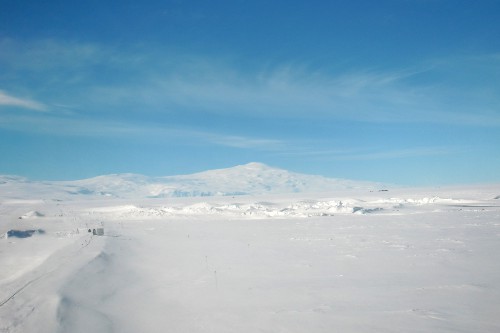As expected, we finally catched the airplane that would take us back to McMurdo Station on the coast of Antarctica. We knew that an airplane from McMurdo had taken to the air at 9:00 am and was already on our way, with an expected arrival time around noon. At its arrival, newcomers to the South Pole would step out, the plane would be refueled, checked out, and then put aloft again in a couple of hours, with all of us South Pole veterans comfortably settled inside. There are television monitors at both the Amundsen-Scott and McMurdo stations that list all planned arrivals and departures, and we spent a good part of the morning following up on those monitors. But anything can happen when traveling in Antarctica. Indeed, the previous day (Tuesday, January 20, our scheduled departure date) a plane had left McMurdo for the pole, but the flight was aborted halfway and had to turn back because of maintenance issues. But to make a long story short, the plane arrived as expected. We boarded around 1:15 pm and took off about 15 minutes later.



When I first arrived at the South Pole I had seen sparkle on the ground, but today I saw sparkle in the air. We were having snow grains flown over the air by the wind, and the visual effect this created was amazing.
Six IceCube members boarded the plane (Mike, Elisa, Sam, Hans, James and I) while three other members remained. Two of them—Marcel and Lionel—are scheduled to leave next week, while Stephan and Erik will remain in the station as winterovers at least until November. As the IceCube website explains (http://icecube.wisc.edu/news/view/84), winterovers are people who essentially remain stranded at the Amundsen-Scott South Pole Station from the time the last plane flies out in mid-February until the next plane lands in early November.



So the airplane took off, an LC-130, which is the same model that had previously taken us from New Zealand to Antarctica. The engines can be so loud that passengers are routinely issued ear plugs to wear during the flight. But flying in an LC-130—which is among the few ski-equipped aircraft in regular use today by the United States—is quite an experience. Its flight is powerful but relaxed, and as explained in a previous posts, its landings are quite graceful.
After a short and pleasant flight the plane we landed at Williams Field, which is located right in the sea ice floor of the Ross Ice Shelf. This is near the edge of Ross Island and about 12 kilometers from McMurdo Station proper. We arrived at 4:45 pm, with a total flight time of 3 hours and 15 minutes. I did not do a passenger count, but there seemed to be about 25 people, plus 4 or 5 crew as usual.


Upon arrival we found a scenery of incomparable beauty. In contrast to the bland weather I experienced during my previous 5-day stay at McMurdo, this time the sky was clear and blue, and the Sun was shining brightly at an elevation of 29° above the horizon. As I stepped down the plane I saw the same place that I had left ten days ago, but in a totally different light. The mountains in the distance looked alive and vibrant. The Transantarctic range was due south, while the peaks of Ross island were clearly visible to the north. Someone pointed out north and I immediately recognized the magnificent silhouette of Mt. Erebus, the world's southernmost active volcano. For a few seconds I admired its beauty and then took a number pictures. To its right I also recognized Mt. Terror which, although a tad less high and a bit farther away from the airfield, still looked impressive. These views were simply not attainable during my previous stay, which is why I had been anticipating an attempt upon my return.


We got our rooms at once and I was fortunate to be again lodged at building 155, a large blue building covering 6,300 square meters (68,000 square feet) and generally considered as the hub of McMurdo Station. Building 155—being host to the dining hall, retail store, library, and also to the main public computer lab—is without a doubt a very convenient place to stay.
Together with the keys to my room I got a note with a name, and a number to page. I had already been told that people from the National Science Foundation (NSF) had taken an interest in my PolarTREC journal postings, but I was pleasantly surprised to learn that NSF officers were present at the station and wanted to meet for an informal meeting. So I talked to Katy who at once introduced me to Lisa (a program director at NSF) and Erika (an Einstein Distinguished Educator fellow). We met just after dinner and had a most interesting chat. Later on we attended together a lecture at the Crary Science Hall on diatom ecology in the McMurdo Dry Valleys and was, in turn, introduced to Dr. Diane McKnight (one of the presenters) who has done work on astrobiology. This unexpected encounter with Katy, Erika, Lisa and Diane was the highlight of my day, and it proved to be absolutely gratifying and inspirational.
El texto estará disponible próximamente.












Comments